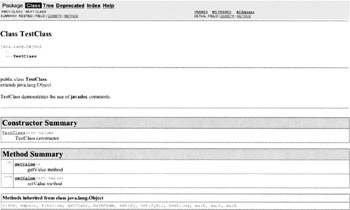Summary
Identifier Naming - Writing Self-Commenting Code
Self-commenting code is an identifier-naming technique you can use to effectively manage both physical and conceptual complexity. An identifier is a sequence of Java characters or digits used to form the names of entities used in your program. Examples of program entities include classes, constants, variables, and methods. All you have to do to write self-commenting code is to 1) give meaningful names to your program entities, and 2) adopt a consistent identifier-naming convention. Java allows unlimited-length identifier names, so you can afford to be descriptive.

Figure 1-4: Example HTML Documentation Page Created With javadoc
Benefits of Self-Commenting Code
The benefits of using self-commenting code are many. First, self-commenting code is easier to read. Code that s easy to read is easy to understand. If your code is easy to read and understand, you will spend much less time tracking down logic errors or just plain mistakes.
Coding Convention
Self-commenting code is not just for students. Professional programmers (real professionals, not the cowboys!) write self-commenting code because their code is subject to peer review. To ensure all members of a programming team can read and understand each other s code, the team adopts a coding convention. The coding convention specifies how to form entity names, along with how the code must be formatted.
When you write programs to satisfy the exercises in Java For Artists I recommend you adopt the following identifier naming conventions:
Class Names
Class names should start with an initial capital letter. If the class name contains multiple words, then capitalize the first letter of each subsequent word used to form the class name. Table 1-2 offers several examples of valid class names:
| Class Name | Comment |
|---|---|
| Student | One-syllable class name. First letter capitalized. |
| Engine | Another one-syllable class name. |
| EngineController | Two-syllable class name. First letter of each word capitalized. |
| HighOutputEngine | Three-syllable class name. First letter of each word capitalized. |
Constant Names
Constants represent values in your code that cannot be changed once initialized. Constant names should describe the values they contain, and should consist of all capital letters to set them apart from variables. Connect each word of a multiple-word constant by an underscore character. Table 1-3 gives several examples of constant names:
| Constant Name | Comment |
|---|---|
| PI | Single-word constant in all caps. Could be the constant value of π. |
| MAX | Another single-word constant, but max what? |
| MAX_STUDENTS | Multiple-word constant separated by an underscore character. |
| MINIMUM_ENROLLMENT | Another multiple-word constant. |
Variable Names
Variables represent values in your code that can change while your program is running. Variable names should be formed from lower-case characters to set them apart from constants. Variable names should describe the values they contain. Table 1-4 shows a few examples of variable names:
| Variable Name | Comment |
|---|---|
| size | Single-word variable in lower-case characters. But size of what? |
| array_size | Multiple-word variable, each word joined by underscore character. |
| current_row | Another multiple-word variable. |
| mother_in_law_count | Multiple-word variable, each word joined by an underscore character. |
Method Names
A method represents a named series of Java statements that perform some action when called in a program. Since methods invoke actions their names should be formed from action words (verbs) that describe what they do. Begin method names with a lower-case character, and capitalize each subsequent word of a multiple-word method. The only exception to this naming rule is class-constructor methods, which must be exactly the same name as the class in which they appear.
| Method Name | Comment |
|---|---|
| printFloor | Multiple-word method name. First letter of first word is lower-case; first letter of second word is upper-case. The first word is an action word. |
| setMaxValue | Multiple-word method name. This is an example of a mutator method. |
| getMaxValue | Another multiple-word method name. This is an example of an accessor method. |
| start | A single-word method name. |
EAN: 2147483647
Pages: 452